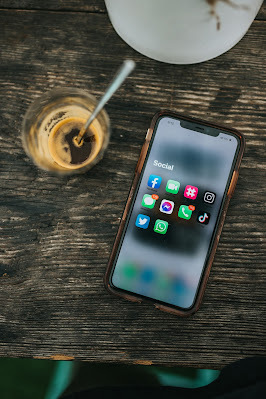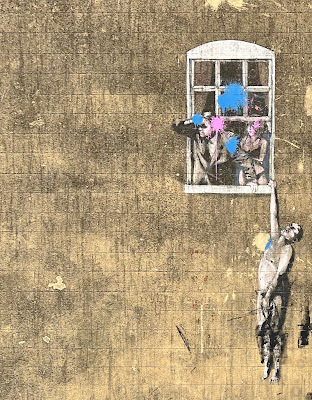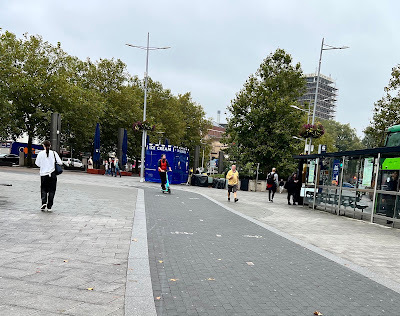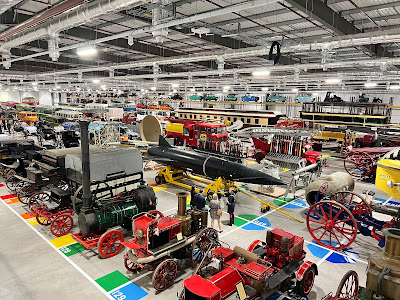Brian Clegg's Blog, page 10
November 11, 2024
Social fragmentation
 Despite all its faults, as a science writer I have found social media wonderful - it allows me to tap into both the science and writing communities, which is excellent for someone working in a job where you don't have much opportunity to meet others in your line of work.
Despite all its faults, as a science writer I have found social media wonderful - it allows me to tap into both the science and writing communities, which is excellent for someone working in a job where you don't have much opportunity to meet others in your line of work.I've been involved in this kind of thing for a while, beginning with an ancient forum (I can't remember where it was hosted) set up by the Society of Authors. I'm still in contact with quite a few writers from this, who can share a wry smile when remembering the lack of foresight from whoever set it up, that a forum titled Writers' Exchange might look a little misleading when the words are run together without an apostrophe.
Until recently, by far the most useful social media site for me was Twitter. It probably still is, but X is declining in value because a number of my long-standing contacts have abandoned it out of dislike for its owner. Personally, I think this amounts to cutting off your nose to spite your face, as it would take a long time for any alternative to generate the same following - and some, such as Mastodon, seem to me too technical and user-unfriendly for mass adoption.
So, I'm not leaving X - but I do now also post on both Bluesky and Threads, and would be very happy to build up my contacts if anyone would care to follow me. My full social broadside is:
Twitter/X - https://x.com/briancleggBluesky - https://bsky.app/profile/brianclegg.bsky.socialThreads - https://www.threads.net/@briancleggauthorFacebook - https://www.facebook.com/briancleggauthorLinkedIn - https://www.linkedin.com/in/brianclegg/I usually post any new stuff on all of them, though the best way to see all my output is to subscribe below.Image by Nathan Dumlao from UnsplashThese articles will always be free - but if you'd like to support my online work, consider buying a virtual coffee:
See all Brian's online articles or subscribe to a weekly email free hereNovember 8, 2024
Keep an eye on your direct debits
 Direct debits are wonderful things. They make it far easier when dealing with, say an energy company, where payments are regular but potentially variable. But I've reasonably discovered a downside, at least if you are involved in a charity or small organisation.
Direct debits are wonderful things. They make it far easier when dealing with, say an energy company, where payments are regular but potentially variable. But I've reasonably discovered a downside, at least if you are involved in a charity or small organisation.I'm treasurer of a small local charity. The other day I was glancing at the bank accounts online and noticed something odd. Two direct debit payments had been made from our account, both for relatively small amounts. Each had a reference starting DVLA- followed by a car registration number. When I had a look at our regular payments there were in fact three direct debits of this kind, though one hadn't had any money taken yet. This was from an account only used for incoming payments.
We had not set up any direct debits - certainly not with the UK's DVLA, which handles car licensing as there are no vehicles associated with the charity. I rang the bank and, to their credit (or, rather, ours) they had refunded the money with 2 hours. But this should not be able to happen.
Traditionally, direct debits could only be authorised with a mandate that had a signature (in the case of our charity, two signatures), which would be checked at the branch against a signature card. Now, though, this is all handled centrally, and direct debits can be set up online. All you appear to need to set one up is the sort code and account number.
After mentioning it on a group for similar charity officials, several others came back and said they'd experienced the same thing. While the bank was very quick to act they have also said '[DVLA reference] must have your permission to take a direct debit... We've asked them to provide proof they had your permission... if they did we may take back the refund.' Now clearly there's a flaw in that statement. They didn't have our permission but still allowed the payment to go out.
I've now been into the bank and they tell me that with an electronic direct debit, set up by someone like the DVLA, no checks are made by the bank at all. They don't even have a mandate - they just rely on the DVLA to ensure details are correct before taking money. Keep an eye on your direct debits!
Image by Museums Victoria from the 1980s on Unsplash - banks aren't like this anymore...These articles will always be free - but if you'd like to support my online work, consider buying a virtual coffee:
See all Brian's online articles or subscribe to a weekly email free hereNovember 4, 2024
Putting sport into perspective revisited
 REVISIT SERIES - An edited post from October 2013
REVISIT SERIES - An edited post from October 2013There was a lot of fuss in some sections of the news recently about runner Mo Farah having problems because someone pushing a child's buggy in the park where Mo was trying to train wouldn't get off the path to keep out of Mo's way.
Now I'm sure Mo is a nice guy, and was very polite, and there certainly shouldn't have been the fight that ensued. But I also am sure that the media outrage that poor old Mo had to suffer so much by not having the path to himself because of this unreasonable father was ridiculous.
Let's get the picture in perspective. Mo is very good at a game, the playground game of 'Who can run fastest?' He's one of the best people in the world at this particular game, and that's lovely for him. But compared with keeping a baby or toddler safe, it is a totally worthless activity. It's fine in its place. If he had been training on a running track and the father and started pushing his pushchair round the track, then of course Mo would have had every right to ask him to get out of the way. But this was a public park, paid for by public money so the public could enjoy using it for, say, pushing prams - not a sports training facility. And for that matter, feet are much better at getting along on grass off the path than buggies are. If anyone was going to get out of the way, it should have been Mo.When our twins were young we had a double buggy and quite often it would be difficult to get along the footpath because some idiot had parked on the pavement far enough in that there was quite a narrow gap between the car and a wall or a hedge. Well, I'm sorry, again the children came first. Rather than go into the road, I would happily scrape my buggy along the side of their car, bash into their wing mirror and generally be as vigorous as possible, because I was in the right place and the car wasn't, and because babies matter more than cars.
So don't ask me to have any sympathy for Mo. He did not have priority because he was the 'big I am' sportsperson. In the right place - and this was the right place - children should always come first.
Image by the author
These articles will always be free - but if you'd like to support my online work, consider buying a virtual coffee:
See all Brian's online articles or subscribe to a weekly email free hereOctober 26, 2024
Radio 3 has it right
 I am a big fan of BBC Radio 3 - their serious music station*. Of late I've seen a few people complaining about it dumbing down because more of their programming has parts of longer compositions, rather than playing, say, a whole symphony or concerto. However, I think that those who moan have got it wrong.
I am a big fan of BBC Radio 3 - their serious music station*. Of late I've seen a few people complaining about it dumbing down because more of their programming has parts of longer compositions, rather than playing, say, a whole symphony or concerto. However, I think that those who moan have got it wrong.The accusation of dumbing down is partly because this is what the lighter commercial rival, Classic FM, does, and partly on the assumption that serious music lovers should stick with a whole piece as the composer intended not just listen to an edited highlight. The comparison with Classic FM, which almost always plays 'classical favourites' doesn't make much sense - Radio 3 continues to play a much wider range of music, from tudorbethan through to contemporary composers. But, for me at least, the sampler approach of often not playing a whole piece makes a lot of sense.
Like many music lovers I subscribe to an all-you-can-eat music streaming service. For me, Radio 3 does a real service by giving me a chance to hear a part of a long composition so I can then decide whether nor not to add it to a playlist on Apple Music to hear the whole thing. This isn't about dumbing down, it's about fitting in better with the way we listen to music while upholding the range that Radio 3 has always had - and surely that's a good thing.
* I say 'serious music' rather than 'classical music' as strictly 'classical' refers only to a period approximately from 1750 to 1820 - and I personally prefer music that's either earlier or later than this period.
Image by Manuel Nageli from UnsplashThese articles will always be free - but if you'd like to support my online work, consider buying a virtual coffee:
See all Brian's online articles or subscribe to a weekly email free hereOctober 19, 2024
But is it art revisited

REVISIT SERIES - An edited post from October 2014
I find it interesting the way that the media gets in a state of outrage when someone defaces a Banksy artwork. It feels a touch hypocritical. The image shown here has according to Wikipedia been 'defaced by a paintball gun’. Actually the 'defacing' is quite effective as it looks as if someone has shot at the people with a paint gun, which itself could be interpreted artistically (in fact, I didn't know it was 'defaced' until I looked it up). Admittedly if all someone does is scrawl a tag over it, it's not a great contribution. But even so, I'm not sure we have any right to complain. The artists in question need to expect that their audiences may abandon the reverence that is adopted by the audience for traditional art.
This occurred to me when a friend was describing attending a play at Bristol's fairly avant garde Old Vic Theatre. Apparently the performance was of a Samuel Beckett radio play, and as Beckett had specified it should never be staged, they told the audience that they had to wear blindfolds. Thinking about this, I realised that my immediate reaction, had I been in the audience, would have been to have cheated and taken the blindfold off once they got started. Because once you break the rules as an artist, why should your audience be forced to stick to rules? It seemed to me that it was just as acceptable for me as an audience member - as art, if you like - to take off my blindfold as it was for the performers and/or the late Mr Beckett to insist that I wear it.As I wasn't there, I don't know how the artists would have reacted. I do know that on other occasions when the audience has not behaved as expected, the answer has been 'not very well.' This was certainly the case in one of the early performances of one of Stockhausen's more approachable pieces, Stimmung. In the piece, lasting about an hour, a cappella performers sing a single chord. However, it is a genuinely interesting piece because they vary how they sing the notes throughout - using different octaves, sounds and words, tones - I rather like it. At the performance in question, the audience members started to join in, singing in their own notes in the chord. Now, to me, that's brilliant.
In an ordinary concert, this would have been disruptive. But given the way Stimmung (it means 'tuning' by the way) corrupts and opens up the form, it seemed both a natural and creative thing to do. Yet Stockhausen was apparent furious and stopped the performance. It might be structured disorder and chaos, but it had to be his structured disorder and chaos. Which makes you wonder, is this about art, or is it about ego? Who was to say that the version with the audience joining in wasn't better? It was certainly likely to have been more enjoyable for them.
So to Banksy. It's interesting that a Metro article on a different modification was titled New Banksy artwork attacked by vandals. It would have been just as accurate, but would underline the potential hypocrisy better, had it been headed New Banksy graffito has more graffiti added. Interestingly, in the case of Banksy, the motivation for the hypocrisy is likely to be more about money, now his pieces are worth a lot, rather than about ego. But even so there is something here that really gets to heart of what art is and what art isn't.
What is the difference between Banksy spraying on a wall and someone else? Because Banksy's art looks prettier? That's hardly a good way of making a distinction in modern art. No one ever accused a Tracy Emin piece of being pretty. Neither is the fact that Banksy's picture takes more skill that the other graffiti artist's scrawl - if you make that suggestion I have two words for you. Jackson Pollock. Does something have to have a message to be art? Arguably the 'vandalism' graffiti have more of a message (however unwanted) than this particular Banksy. As far as I can see, the only difference is that Banksy's graffito was witty. But is that enough? Should that really transform vandalism into art?
Don't get me wrong, I like Banksy's work. I think it genuinely is art. But I suggest that it underlines the way we need to get the skill back into modern art. Banksy is very skilful. His work looks good and gets the message across. It shouldn't be enough that any old tat can be interpreted as art if you give it the right label. A true artist needs more than that. Otherwise, perhaps, he or she is just a piss artist.
Intrigued at the thought of Stimmung? Take a listen (darkened room and medication recommended):
Image by the author
These articles will always be free - but if you'd like to support my online work, consider buying a virtual coffee:
See all Brian's online articles or subscribe to a weekly email free hereOctober 18, 2024
First Light - A Celebration of Alan Garner - Ed. Erica Wagner ***
 I have been a fan of the British fantasy writer Alan Garner since meeting him, age 11. Garner attended the same school as me (significantly earlier), and came to give a talk, not to a huge auditorium but just a classroom of young readers.
I have been a fan of the British fantasy writer Alan Garner since meeting him, age 11. Garner attended the same school as me (significantly earlier), and came to give a talk, not to a huge auditorium but just a classroom of young readers. For nearly a decade he brought out books that almost perfectly aged with me in their target audience, from The Weirdstone of Brisingamen to Red Shift (with the last we parted company as I found it too depressing). I was sufficiently fascinated by his books that I made a home movie in the late 70s visiting many of the locations used in them.
For those who remember the copper mine on Alderley Edge used evocatively in his writing as a dark underground location, a friend and I (probably illegally) explored a bit of it - which is where the photos below come from. In The Weirdstone there is a strange booming noise in the mine, coming from the goblin-like creatures, which meant we did eventually decide to leave in a hurry when we heard a similar sound.
This is all an extremely long lead up to why I couldn't resist buying a copy of First Light when I saw it advertised at a discounted price (it originally came out in 2016). I am probably glad I did, though it was a mixed experience. The book pulls together commentary on Garner's writing, many stories of people meeting up with the Garners, biographical material and even short fiction and poems inspired by Garner (one, oddly by a previous Archbishop of Canterbury).
 There were some gems in here, particularly from writers inspired as I was by Garner's early books. I was also fascinated to read about Garner's short time as a running companion to Alan Turing. There is also a lot of repetition from people who admired his writing saying the same kind of thing... and a fair amount of pretentious commentary. Getting through this can make the reader feel something of a Treacle Wader (bad in-joke for Garner fans). All in all, I'm glad I bought it, but I can't imagine I'll ever read it again - though it has stimulated me to re-read those early novels.
There were some gems in here, particularly from writers inspired as I was by Garner's early books. I was also fascinated to read about Garner's short time as a running companion to Alan Turing. There is also a lot of repetition from people who admired his writing saying the same kind of thing... and a fair amount of pretentious commentary. Getting through this can make the reader feel something of a Treacle Wader (bad in-joke for Garner fans). All in all, I'm glad I bought it, but I can't imagine I'll ever read it again - though it has stimulated me to re-read those early novels.
Images by the author
You can buy First Light from Amazon.co.uk Amazon.com and Bookshop.org
These articles will always be free - but if you'd like to support my online work, consider buying a virtual coffee:
See all Brian's online articles or subscribe to a weekly email free hereOctober 17, 2024
Surviving the Bristol bike lane
 At the moment I’m commuting to Bristol once a week to do some work at the university on behalf of the Royal Literary Fund. I’m very fond of Bristol as a city, but there times when I wonder if their green policies have been entirely thought through.
At the moment I’m commuting to Bristol once a week to do some work at the university on behalf of the Royal Literary Fund. I’m very fond of Bristol as a city, but there times when I wonder if their green policies have been entirely thought through.When they first introduced rental e-scooters I pointed out that they were sometimes left in hazardous locations - this seems less the case now, though I did come across one recently nearly blocking a pedestrian crossing. But the most dangerous aspect is some of the central bike lanes.
I’m all in favour of getting people out of cars and buses, but I wish there was more focus on walking. This is significantly better for you over a particular time duration than using a bike or e-scooter - but that’s not my point. Inevitably fitting bike lanes into an old city centre can be tricky. And some of them here are downright dangerous. The only time I’ve been nearly killed by a bicycle was someone coming down the steep slope of Park Street in Bristol and transitioning from the bike lane to the pavement at about 30 miles per hour.
Of all the facilities for bike riders, though, the one portrayed above strikes me as particularly dangerous. The bike lane runs through a large stretch of pavement - but it is only distinguished by colour and a change of paving stone. There are no effective tactile warnings that you are entering a bike lane on foot for those with limited sight - and the riders show no care for stray pedestrians who may not even know that the darker bit is a bike line (there are a few faded markings on the ground, but that’s all - no big clear signs). At one point you have to cross the bike lane to continue on the pavement. This is marked (again, only on the ground) to show bikes should give way to pedestrians - but I’ve never seen that happen.
People do get seriously injured and even killed when bikes collide with pedestrians. This needs a re-think.
Image by the author
These articles will always be free - but if you'd like to support my online work, consider buying a virtual coffee:
See all Brian's online articles or subscribe to a weekly email free hOctober 11, 2024
The Science Museum goes large

To the south of Swindon, just outside the village of Wroughton (where my daughters went to school) is what's now rather grandly known as the Science and Innovation Park. This huge 540 acre site houses the Science Museum's store facility. It's also home to the museum's amazing library, where I can be seen telling the (then) BBC's Robert Peston about quantum theory - and acted as a track for the TV show Grand Tour before it stopped being a Top Gear lookalike.
 Last Tuesday, I was honoured to be invited to the unveiling of the new Hawking Building a massive store housing over 300,000 items from the huge to the tiny. The scale of the building is remarkable - it really does look like one of those CGI, bigger than anything you can really imagine, store houses you see in movies. But this is for real.
Last Tuesday, I was honoured to be invited to the unveiling of the new Hawking Building a massive store housing over 300,000 items from the huge to the tiny. The scale of the building is remarkable - it really does look like one of those CGI, bigger than anything you can really imagine, store houses you see in movies. But this is for real.Walking round is quite an experience. Unlike a modern, carefully curated museum, this is a wonderful jumble, where you might find a Dalek lurking near a submarine alongside a Glasgow tram. Not to mention a plastic duck used as a model of comet 67P/ Churyumov–Gerasimenko. There is so much to see it's hard to take everything you are seeing (a tiny fraction of the contents).

Its main reason for existence isn't as an exhibition space. I was talking to one of the curators who said it is transformative for them, as they can locate any one these many thousands of objects extremely quickly - and it's all easily accessible for study or to be moved to a display.
Even though it is primarily a store, it is regularly open to the public on guided tours (see the Park's link above for visit opportunities). This being the case, my one small moan is that it would be good if visitors could, say, use an app to identify what objects are - most aren't labelled other than by catalogue number.
Congratulations to the Science Museum team for getting this amazing structure up and running, and giving more access to the public than ever before.
Images by the author.These articles will always be free - but if you'd like to support my online work, consider buying a virtual coffee:
See all Brian's online articles or subscribe to a weekly email free hereOctober 9, 2024
Word of mouth goes global revisited
 REVISIT SERIES -
REVISIT SERIES - An edited post from October 2009
Some of the old posts I'm revisiting are merely still interesting (hopefully), but I was surprised to see as far back as 2009 that the impact of social media on the spread of news and views was already clear, even if I perhaps underplayed the negatives. It's also notable as I had totally forgotten about this story in writing my new book, Brainjacking, out next month, which very much picks up on the way the ability of storytelling to inform, influence and manipulate has been amplified by technology, from writing through to AI.
There has been much comment and complaint in the electronic world as a result of Jan Moir's unpleasant Daily Mail article about the death of Stephen Gately.
What I found most fascinating was how out of touch Moir was in her response to the wave of complaint that surged around the internet like a tsunami. She described this as a 'heavily orchestrated internet campaign.' This shows a magnificent lack of understanding of how word spreads around vehicles like Twitter and Facebook.A 'campaign' like this doesn't need to be orchestrated - if it strikes the right nerve, it will grow and grow. The only difference between this and old, literally word-of-mouth responses is that Twitter, with its high speed and greater connectivity, ensures that any such reaction will take place in hours rather than weeks.
Twitter's role in the Moir affair also underlines the wisdom of something Malcolm Gladwell once wrote. I think it was in The Tipping Point that he suggests that there are some super-connected people, who push a trend out to a much larger network than the average person. On Twitter, such super-connected people are much more obvious and with an even bigger network. An obvious example is Stephen Fry, who claims he was very much a Johnny-come-lately to the Moir effect, but would still have provided a ramping up of the Twitter response. People like Fry act like amplifiers in a circuit, suddenly hugely boosting a signal.
It's fascinating, and though there are many people who over-emphasise the power of Twitter and Facebook, I still do think that they are changing the way we communicate, and so far (unless you are Jan Moir) the effect has largely been positive.
Image by Ravi Sharma from Unsplash.
These articles will always be free - but if you'd like to support my online work, consider buying a virtual coffee:
See all Brian's online articles or subscribe to a weekly email free hereOctober 5, 2024
The best advice I got as a newly published author
 When I wrote my first popular science book,
Light Years
, I got some lovely reviews - and one or two stinkers. I asked my editor if I should respond to the negative remarks. She said 'Definitely not - unless the review contains something that's factually untrue, you only do yourself damage by attempting to put straight what is, in the end, an opinion.'
When I wrote my first popular science book,
Light Years
, I got some lovely reviews - and one or two stinkers. I asked my editor if I should respond to the negative remarks. She said 'Definitely not - unless the review contains something that's factually untrue, you only do yourself damage by attempting to put straight what is, in the end, an opinion.'This is an attitude I've stuck with through thick and thin. Since then I have also reviewed many hundreds of books. I have only twice had an author or publisher kick back against a negative review. One was of an adult colouring book (a genre, I confess, I detest - I ought to stress I didn't ask for a review copy, I was sent it unsolicited), where the author felt that, as an author myself, I was letting the side down - we've all got to earn a living. I did, as a result, remove my review from Amazon.
The other has just happened - and the response was not just a moan. Either an author or the publisher put in a DMCA request to have the review taken down, which the host for my reviews did. There was in theory an opportunity to counter claim, but the links provided by the host for this process (a well-known search engine company beginning with G) only pointed to a page for reporting an issue, not for countering a claim, so it didn't prove possible. If I'm honest, I can't be bothered to fight to restore a review of a book from four years ago I didn't particularly like.
The complaint itself was entirely specious. The review only contained one quote: 'Electric vehicles are cheaper. Autonomous vehicles are too...' - and it's perfectly acceptable to use short quotations for illustrations in a review. Clearly that wasn't the reason - it was just that someone didn't like the review. Shame on them. That's not playing the game.
I have emailed the publisher to point out that this isn't a great thing to do - I'll let you know if they respond.
Image by Julien L from UnsplashThese articles will always be free - but if you'd like to support my online work, consider buying a virtual coffee:
See all Brian's online articles or subscribe to a weekly email free here


